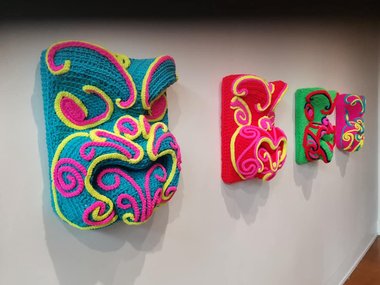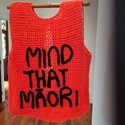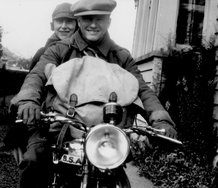Scott Hamilton – 20 August, 2020
With their vivid colours and unashamedly unconventional materials, Lissy and Rudi Robinson-Cole connect Whare Harikoa with Rongopai. And, looking at the Robinson-Coles work, I found my understanding of Rongopai, Ringatu, and Te Kooti change. The Robinson-Cole show was full of joy, and took mischievous pleasure in its unusual materials.
Auckland
Lissy and Rudi Robinson-Cole
Ka Puawaita: coming to fruition
24 July - 13 September 2020 (prelockdown dates)
Histories of art tend to tell a certain type of story, a story with a beginning, a middle, and an end. In this narrative, one generation of artists influences or reacts against another. Styles are pioneered, perfected, abandoned. Giotto leads eventually to Michelangelo; Picasso succeeds Cezanne.
I don’t believe such varieties of story. I think that the history of art is less a stream flowing in one direction than a series of Einsteinian wormholes, which open and close unexpectedly and connect sometimes remote parts of spacetime. Conventional history says that the artists of the present cannot influence their antecedents, that the masterpieces of the past are complete, secure, dead. But quantum physicists claim that events in the present can change details of the past, and it seems to me that, when we look at old art in new ways, in ways inspired by contemporary art, then we alter what we see.
A few days before the plague returned to Auckland, and closed the city’s galleries, I visited Corban Arts Estate, where Lissy and Rudi Robinson-Cole were holding an exhibition called Ka Puawaita: coming to fruition. Rudi Robinson-Cole carves chunks of polystyrene; Lissy Robinson-Cole covers his shapes with bright crocheted yarn. Their works have names, images, and patterns that evoke Māori cosmology, Māori politics, Māori meteorology. Visitors to Corban Arts Estate could recognise tiki, the Tino Rangatiratanga flag, the stars of Matariki.
But the Robinson-Coles’ psychedelic colours and unusual materials scrambled any coordinates I had brought to their show. In the gallery’s largest room they had arranged two polystyrene pou, decorated with pink woollen tiki. The pou will be part of a ‘Whare Harikoa’ that the Robinson-Coles are slowly constructing. In a brochure accompanying the exhibition they explained that the building will ‘reimagine the experience of the wharenui’, and be a ‘visually joyful place’. Elsewhere in their text the Robinson-Coles acknowledged have turned away from the ‘earthy tones and colours’ characteristic of much Māori art. They talked of their love of ‘neon colours’, and their belief that crochet—an apparently a fusty, unfashionable artform imported to Aotearoa—could connect the Māori past and present.
As I stared at the Robinson-Coles’ pou and imagined their wharenui, I felt a wormhole open, a tunnel that connected a room in twenty-first century Auckland to the East Coast kainga of Waituhi in the spring of 1887. In a few frenzied weeks, the people of Waituhi raised and decorated one of the most remarkable buildings in Aotearoa, the meeting house called Rongopai. Rongopai was built in honour of the guerrilla fighter, poet, and theologian Te Kooti Arikirangi Te Turuki, who was riding towards Poverty Bay with an entourage of hundreds.
After making peace with the Pakeha government in 1883, Te Kooti had travelled by horse and cart across Te Ika a Maui, winning converts for the Ringatu church he had founded. Te Kooti never reached Waituhi: an improvised army of Pakeha and kupapa Māori rode out of Gisborne and blocked the way to the coast. But Rongopai remained.
Rongopai was designed by Moanaroa Pere. Like the dozens of other wharenui built for Te Kooti, it violated tapu after tapu. The figures that decorated meeting houses had traditionally been carved; the figures at Rongopai were painted. Only the dead had traditionally been depicted inside wharenui; Rongopai boasted paintings of many living people, including Moananoa Pere himself, who was shown welcoming visitors by the building’s porch. With a few exceptions, traditional wharenui used earthy, muted colours; Rongopai’s walls, ceilings, and pou were covered in greens, yellows, orange, bright shades of red. In her great biography of Te Kooti, Judith Binney talked of the building’s ‘florescence’.
Rongopai’s imagery had Pakeha as well as Māori sources. There was a racehorse and a jockey, there were the four emblems of the card pack, there was a boxing match, there were flowers escaping from vases, and there was a Scottish thistle, which may or may not—oral traditions disagree—have been intended to represent Te Kooti himself.
Rongopai may have featured the living, but it did not neglect the dead. One of the largest paintings on its pou showed Mahaki, an ancestor of the people who lived at Waituhi. But Mahaki was presented without a moko, that emblem of chiefly mana. His bare face was shocking; it removed him from the safety of history, and made him a contemporary of Te Kooti, an inhabitant of colonised Aotearoa.
Te Kooti was leading a people whose lifeways had been broken by Pakeha invaders and expropriators. As land and wealth had been lost, arts like carving and tattooing had been disrupted, sometimes lost. Ancient tapu had been broken by the enemy. In the art they made at Rongopai and other Ringatu wharenui, Te Kooti’s people both assimilated and mastered the imagery and materials of the Pakeha. Binney called Rongopai a ‘wondrous, populated, Eden’. The wharenui at Waituna exemplified the new order that Te Kooti promised to create on the ruins of the old. Rongopai was so powerful that conservative Rangatira put a partial tapu on it. For eighty years, the house could be used only for occasional Ringatu services.
Early in the twentieth century Apirana Ngata put a tapu of his own on Rongopai and the other Ringatu masterpieces. Ngata regretted the houses’ substitution of painting for carving, winced at their psychedelic colours, and decried their modern imagery. At his Rotorua School of Māori Arts, Ngata made sure that pupils used only a few traditional colours, carved only safely dead ancestors, and avoided almost all reference to the twentieth century. But in the late twentieth century Roger Neich published a survey of the Ringatu houses, and painters like Shane Cotton began downloading images from Rongopai.
With their vivid colours and unashamedly unconventional materials, Lissy and Rudi Robinson-Cole connect Whare Harikoa with Rongopai. And, looking at the Robinson-Coles work, I found my understanding of Rongopai, Ringatu, and Te Kooti change. The Robinson-Cole show was full of joy, and took mischievous pleasure in its unusual materials. The same qualities can surely be found at Rongopai and in the other Ringatu wharenui, though it is easy to miss them, given the tragic era in which they were made.
Like Te Kooti’s artists, the Robinson-Coles incorporate novel imagery into their work in a joyful, almost nonchalant manner. In a work called Sweet Jungle of Mine, Lissy Robinson-Cole has let ragged lengths of fluorescent yarn dangle over strips of embellished fabric donated to her by the Supreme Sikh Society of New Zealand. With its intricate but obscure patterning, the fabric is as promising and as threatening as a distant clearing seen through jungle vines. Perhaps Sweet Jungle of Mine is the beginning of a larger collaboration, one that can open a new wormhole, a tunnel to a different region of spacetime.
Scott Hamilton





 Advertising in this column
Advertising in this column Two Rooms presents a program of residencies and projects
Two Rooms presents a program of residencies and projects



This Discussion has 0 comments.
Comment
Participate
Register to Participate.
Sign in
Sign in to an existing account.